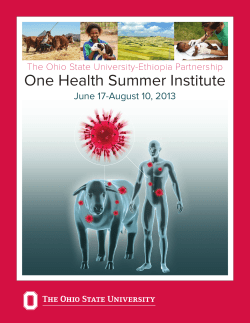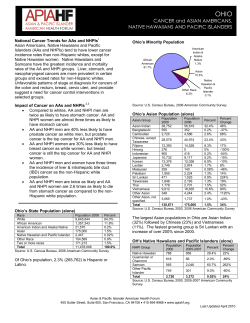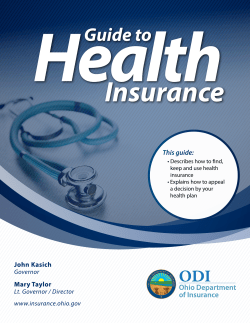
S t o m a ch C a... i n O h i o , ... -
October 2012 Page 1 Stomach Cancer in Ohio, 2005-2009 This report contains a summary of incidence and mortality rates, stage at diagnosis, survival, histology, risk factors and signs and symptoms for stomach cancer in Ohio and the United States. Stomach Cancer Incidence and Mortality Stomach cancer made up 1.3 percent of the incident (newly diagnosed) cancers reported to the Ohio Cancer Incidence Surveillance System (OCISS) from 2005 through 2009. The average annual number (N) of cases of stomach cancer in Ohio during this time period was 764 and the average annual age-adjusted incidence rate was 6.0 cases per 100,000 persons, which is lower than the U.S. (SEER: Surveillance, Epidemiology and End Results) rate of 7.6 per 100,000 persons (Table 1). Estimated completeness of reporting for stomach cancer in Ohio was 86 percent in 20052009, which is 9 percent less than the national standard of 95 percent for complete case ascertainment. Therefore, the stomach cancer incidence rates presented in this report may underestimate the true stomach cancer burden in Ohio. The Ohio stomach cancer mortality rate of 3.3 deaths per 100,000 persons in 2005-2009 is slightly lower than the U.S. (NCHS: National Center for Health Statistics) mortality rate (3.6 per 100,000 persons) (Table 1). As shown in Table 1, in both Ohio and the United States, stomach cancer incidence and mortality rates were greater for males, blacks, Asian/Pacific Islanders and those 65 years and older. Key Findings • Ohio and U.S. stomach cancer incidence and mortality rates were greater for males, blacks and Asian/Pacific Islanders and those 65 years and older. • For all race-gender groups, incidence rates were greater in the United States, compared to Ohio, possibly due to lower completeness of reporting in Ohio. • Incidence and mortality rates were higher in the northeast area of Ohio. • From 1996 to 2009, incidence rates were relatively stable, except for black males for whom the rate was highly variable and decreased. • From 1996 to 2009, mortality rates decreased for all gender-race groups. • Thirty-one percent of males and 27 percent of females were diagnosed at distant stage in Ohio. • Only 26.9 percent of individuals diagnosed with stomach cancer survive five years after diagnosis. • Smoking tobacco, over-consuming smoked, salted or pickled foods, lack of physical activity and obesity are modifiable risk factors for stomach cancer. Table 1: Stomach Cancer: Average Annual Number (N) and Age-adjusted Rates of Invasive Cancer Cases and Cancer Deaths by Gender, Race and Age Incidence N Total Gender Males Females Race White Black Asian/Pacific Islander Age <64 65+ Mortality Ohio Rate U.S. Rate 764 6.0 7.6 469 295 8.7 4.1 10.5 5.3 627 114 11 5.5 10.0 12.0 251 513 2.2 32.7 N Ohio Rate U.S. Rate 419 3.3 3.6 248 171 4.7 2.3 5.0 2.6 6.6 11.9 12.6 337 76 5 2.9 6.9 4.8 3.1 6.9 6.8 2.9 39.7 115 304 1.0 19.1 1.2 20.0 Source: Ohio Cancer Incidence Surveillance System and the Office of Vital Statistics, Ohio Department of Health, 2012; SEER: Surveillance, Epidemiology and End Results Program, National Cancer Institute, 2012; NCHS: National Center for Health Statistics, 2012. Page 2 Stomach Cancer Incidence and Mortality Rates by Race and Gender in Ohio Compared to the United States Figure 1: Stomach Cancer: Average Annual Age-adjusted Rates of Invasive Cancer Cases and Cancer Deaths by Race and Gender in Ohio and the U.S., 2005-2009 20 Rate per 100,000 Persons 18 16 17.0 14 12 13.1 10 8 6 8.1 9.3 8.9 4 3.5 2 8.6 8.7 4.4 4.2 10.3 4.9 4.3 White Black White Males Black Females White Black White Males Incidence Ohio 2.2 2.0 0 4.8 Black Females Mortality US Source: Ohio Cancer Incidence Surveillance System and the Office of Vital Statistics, Ohio Department of Health, 2012; Surveillance, Epidemiology and End Results Program, National Cancer Institute, 2012; National Center for Health Statistics, 2012. As shown in Figure 1, black males had the highest average annual age-adjusted stomach cancer incidence and mortality rates in Ohio and the United States in 2005-2009. White females had the lowest incidence rates in both Ohio and the United States and black and white females had the lowest mortality rates in Ohio. For each gender-race-specific group, incidence rates were greater in the United States, compared to those in Ohio. This is likely the result of low (86%) estimated completeness of reporting for stomach cancer in Ohio. However, mortality rates for each gender-race-specific group were also lower in Ohio, compared to those in the United States. For both white and black females, the U.S. mortality rates were more than two times the Ohio mortality rates. The reason(s) for this difference is unknown. Did You Know? Asian/Pacific Islanders have lower incidence rates than whites for most common cancers. However, they suffer more often from cancers that are related to infections. One risk factor for stomach cancer is infection with a bacterium called Helicobacter pylori, or H. pylori. Although additional study is needed, infection with H. pylori may explain, in part, why Asian/Pacific Islander populations have higher rates for this type of cancer. Page 3 Stomach Cancer Incidence by Age As shown in Figure 2, for both males and females, stomach cancer incidence rates increased with advancing age. There were very few stomach cancers diagnosed among those younger than 40 years. Stomach cancer incidence rates were similar for males and females up to ages 45 to 49 years; whereas males had approximately double the rate of stomach cancer compared to females 50-54 years and older. Figure 2: Stomach Cancer: Age-specific Incidence Rates per 100,000 Persons, by Gender in Ohio, 2005-2009 80 Rate per 100,000 Persons 70 60 50 40 30 20 10 0 //25-29 Males 30-34 35-39 Females 40-44 45-49 50-54 55-59 60-64 65-69 70-74 75-79 80-84 85+ Age Group Source: Ohio Cancer Incidence Surveillance System, Ohio Department of Health, 2012. Stomach Cancer Incidence and Mortality by County of Residence Figure 3 (page 4) and Figure 4 (page 5) present 2005-2009 average annual numbers (N) and ageadjusted stomach cancer incidence and mortality rates, respectively, by county of residence. Countyspecific incidence rates in Ohio ranged from 1.7 to 10.6 per 100,000 persons (Figure 3) and mortality rates ranged from 1.5 to 6.2 per 100,000 persons (Figure 4). Figures 3 and 4 are similar because the survival probability for stomach cancer is relatively low. Higher stomach cancer incidence and mortality rates tend to concentrate in the northeastern counties of Ohio. In contrast, northwestern Ohio appears to have a concentration of counties with lower incidence rates. Suppression of rates due to small numbers makes it difficult to discern a similar geographic pattern for mortality. Data used to generate these maps can be found in Tables 5 and 6, on pages 14 and 15 of this document, respectively. Page 4 Figure 3: Stomach Cancer: Average Annual Number of Cases (N) and Age-adjusted Incidence Rates per 100,000 Persons, by County of Residence in Ohio, 2005-2009 Source: Ohio Cancer Incidence Surveillance System, Ohio Department of Health, 2012. N = Average number of cases per year (=Total cases in 2005-2009 ÷ 5 years). Each category represents approximately 25% of the 88 Ohio counties. Page 5 Figure 4: Stomach Cancer: Average Annual Number of Deaths (N) and Age-adjusted Mortality Rates per 100,000 Persons, by County of Residence in Ohio, 2005-2009 Source: Ohio Cancer Incidence Surveillance System and the Office of Vital Statistics, Ohio Department of Health, 2012. N = Average number of deaths per year (= Total cases in 2005-2009 ÷ 5 years). Each category represents approximately 25% of the 88 Ohio counties. N/A: Rates may be unstable and are not presented when the case count for 2005-2009 is less than five (i.e., N<1). Page 6 Stomach Cancer Incidence and Mortality Trends Figure 5 shows stomach cancer incidence rates according to year of diagnosis (1996 through 2009) by gender-race group. For each year, black males had the highest incidence rate, while white females had the lowest incidence rate. For each gender-race group, with the exception of black males, rates tended to be relatively constant from 1996 to 2009. The incidence rates for black males were more sporadic over this time period but tended to decrease over time. Figure 6 shows stomach cancer mortality rates according to year of death (1996 through 2009) by gender-race group. For each year, black males had the highest mortality rate, while white females had the lowest mortality rate. Mortality rates remained relatively stable for white females, but there was a decreasing trend for the remaining gender-race groups. The mortality rate for black males was very high in 1996 but stabilized somewhat from 1997 to 2009; the reason for this is unknown. Figure 5: Stomach Cancer: Trends in Annual Age-adjusted Incidence Rates per 100,000 Persons, by Race and Gender in Ohio, 1996-2009 Rate per 100,000 Persons 25 20 15 10 5 0 1996 1997 1998 1999 White Male 2000 2001 2002 Black Male 2003 2004 2005 2006 White Female 2007 2008 2009 Black Female Source: Ohio Cancer Incidence Surveillance System, Ohio Department of Health, 2012. Figure 6: Stomach Cancer: Trends in Annual Age-adjusted Mortality Rates per 100,000 Persons, by Race and Gender in Ohio, 1996-2009 Rate per 100,000 Persons 20 18 16 14 12 10 8 6 4 2 0 1996 1997 1998 White Male 1999 2000 2001 Black Male 2002 2003 2004 2005 White Female 2006 2007 2008 2009 Black Female Source: Ohio Cancer Incidence Surveillance System and the Office of Vital Statistics, Ohio Department of Health, 2012. Page 7 Stomach Cancer by Stage at Diagnosis Figure 7 shows the proportion of stomach cancers by stage at diagnosis and gender for Ohio in 20052009 and the United States in 2002-2008. Stage at diagnosis was relatively evenly distributed between localized, regional and distant stages in Ohio and the United States. Approximately one-third of all stomach cancer cases were diagnosed at distant stage. A slightly higher proportion of males in Ohio and the United States were diagnosed at the regional and distant stages, while a slightly higher proportion of females was diagnosed at the localized stage. There were higher proportions of unstaged/unknown stage among males and females in Ohio, as compared to the United States, and, as a result, there were lower proportions of localized, regional and distant stages among both males and females in Ohio, compared to the United States. Figure 7: Stomach Cancer: Proportion of Cases (%) by Stage at Diagnosis and Gender in Ohio, 2005-2009, and the U.S. (SEER), 2002-2008 50% 9% 0% Male Female Male Localized Ohio Female Male Regional Female Male Distant 13% 22% 32% 27% 35% 31% 28% 25% 33% 30% 27% 19% 10% 23% 20% 24% 30% 20% Percent 40% Female Unstaged/Unknown US Source: Ohio Cancer Incidence Surveillance System, Ohio Department of Health, 2012; SEER: Surveillance, Epidemiology and End Results Program, National Cancer Institute, 2012. The proportions of stomach cancer cases diagnosed at each of the stages, from 1996 to 2009, is shown in Figure 8. Although there were increases and decreases over time for each stage, proportions in 1996 were relatively similar to those in 2009. There was a slight increase in the proportion of stomach cancers diagnosed at the localized stage and there were slight decreases in the proportions of cases diagnosed at the regional stage and unstaged/unknown stage. Years with higher proportions of stomach cancer cases diagnosed at the distant stage (2004-2009) conversely had lower proportions of cases reported with an unstaged/unknown stage. Figure 8: Stomach Cancer: Trends in Proportion of Cases (%) by Stage at Diagnosis in Ohio, 1996-2009 35% Percent 30% 25% 20% 15% 10% 5% 0% 1996 1997 Local 1998 1999 2000 2001 Regional 2002 2003 2004 2005 Distant Source: Ohio Cancer Incidence Surveillance System, Ohio Department of Health, 2012. 2006 2007 2008 Unstaged/Unknown 2009 Page 8 Stomach Cancer Survival Probability Table 2: Stomach Cancer: Five-year Survival Probability (%) by Stage at Diagnosis, Race and Gender in the U.S. (SEER), 2002-2008 Five-year Survival Probability (%) Overall White Male White Female Black Male Black Female All Stages 26.9% 23.6% 28.4% 22.9% 31.1% Localized 62.3% 58.4% 64.0% 56.8% 62.6% Regional 27.7% 25.5% 28.6% 23.1% 28.3% 3.7% 3.3% 3.2% 4.1% 7.3% 17.9% 13.3% 19.1% 15.1% 24.0% Stage Distant Unstaged/ Unknown Stage Source: SEER: Surveillance, Epidemiology and End Results Program, National Cancer Institute, 2012. Table 2 shows that the U.S. (SEER) five-year stomach cancer survival probability in 2002-2008 for all stages combined was only 26.9 percent. Black males had the lowest five-year survival probability (22.9 percent) and black females had the highest (31.1 percent). Survival probability decreased with advancing stage for all race-gender groups. Survival probability also decreased with advancing age (not shown in Table 2). Over the past three decades, five-year survival probability for stomach cancer has nearly doubled, from 15.3 percent among those diagnosed in 1975-1977 to 27.6 percent among those diagnosed in 20022008 (not shown in Table 2.) Stomach Cancer Treatment The choice of treatment depends mainly on the size and location of the tumor, the stage of disease and general health status. Treatment for stomach cancer may involve surgery, chemotherapy, or radiation therapy, often in combination. For example, chemotherapy may be given before or after surgery, often at the same time as radiation therapy. Page 9 Stomach Cancer by Histology Table 3 shows average annual numbers and percents of stomach cancers in Ohio and the United States according to histology. The majority of stomach cancer cases diagnosed from 2005 to 2009 in both Ohio and the United States were carcinomas (90.6 and 94.1 percent, respectively). A higher percentage of stomach cancers in Ohio were diagnosed as “unspecified, carcinoma, NOS” or as “unspecified” (7.4 percent), compared to the United States (3.1 percent). That is, in Ohio, fewer stomach cancers were diagnosed with specific histologies. Table 3: Stomach Cancer: Average Annual Number (N) and Percent Distribution by Histology in Ohio and the U.S. (SEER), 2005-2009 (Average Annual N= 764) Ohio Histology a N U.S. Percent Percent 693 90.6% 94.1% 5 0.7% 0.8% 5 0.7% 0.7% 620 81.2% 85.1% 424 55.5% 49.2% Adenocarcinoma, intestinal type (8144) 34 4.4% 8.2% Carcinoma, diffuse type (8145) 13 1.7% 3.1% 4 0.6% 0.8% 12 1.6% 1.5% 4 0.5% 0.7% 112 14.7% 17.6% 16 2.1% 4.0% 43 5.6% 5.6% 24 3.2% 2.6% 2 0.2% 0.2% Other specific types (8720-8790,8930-8936,8950-8983,90009030,9060-9110,9260-9365,9380-9539) 38 4.9% 5.2% Unspecified (8000-8005) 32 4.2% 0.5% Carcinoma Epidermoid carcinoma (8051-8131) b Squamous cell carcinoma (8070-8078, 8083-8084) Adenocarcinoma (8050,8140-8147,8160-8162,81808221,8250-8507,8514,8520-8551,8560,85708574,8576,8940-8941) Adenocarcinoma, NOS (8140) Linitus plastica (8142) Mucinous adenocarcinoma (8470-8473, 8480, 8482) Mucin-producing adenocarcinoma (8481) Signet ring adenocarcinoma (8490) c Other adenocarcinoma Other specific carcinomas (8012-8015,8030-8046,81508155,8170-8175,8230-8249,8508,8510-8513,85618562,8575,8580-8671) Unspecified, "Carcinoma, NOS" (8010-8011, 8020-8022) Sarcoma and other soft tissue tumors (8680-8713,88008921, 8990-8991,9040-9044,9120-9136,9150-9252,93709373,9540-9582) Source: Ohio Cancer Incidence Surveillance System, Ohio Department of Health, 2012; SEER: Surveillance, Epidemiology and End Results Program, National Cancer Institute, 2012. a Excludes Kaposi Sarcoma, mesothelioma, lymphomas, leukemias, myelomas, lymphoreticular, and immunoproliferative diseases. b Epidermoid carcinoma includes squamous, basal and transitional cell carcinomas. c Other adenocarcinomas includes histologies 8050, 8141, 8143, 8146-8147, 8160-8162, 8180-8221, 8250-8469, 84748479, 8483-8489,8491-8507, 8514, 8520-8551, 8560, 8570-8574, 8576, 8940-8941. Page 10 Stomach Cancer Risk Factors and Populations at High Risk Having one or more risk factors does not mean that a person will develop stomach cancer. Most people who have risk factors never develop stomach cancer. According to the National Cancer Institute, the following have been identified in studies as stomach cancer risk factors or as populations with high risk of stomach cancer: Age — Risk increases with age, with most cases occurring after age 60. Gender — Males are about twice as likely to develop stomach cancer compared to females. Race and Ethnicity — Asian/Pacific Islanders, African Americans and Hispanics are more likely to develop stomach cancer compared to other races and non-Hispanics. Helicobacter pylori infection — H. pylori is a bacterium that commonly infects the inner lining (the mucosa) of the stomach. Infection with H. pylori can cause stomach inflammation and peptic ulcers. It also increases the risk of stomach cancer, but only a small number of infected people develop stomach cancer. Long-term Inflammation of the Stomach — People who have conditions associated with long-term stomach inflammation (such as the blood disease pernicious anemia) are at increased risk of stomach cancer. Also, people who have had part of their stomach removed may have long-term stomach inflammation and increased risk of stomach cancer many years after their surgery. Tobacco Smoking — Smokers are more likely than nonsmokers to develop stomach cancer. Heavy smokers are most at risk. Family history — Persons who have close relatives (parents, brothers, sisters, or children) with a history of stomach cancer are somewhat more likely to develop the disease themselves. If many close relatives have a history of stomach cancer, the risk is even greater. Poor Diet, Lack of Physical Activity and Obesity — Studies suggest that people who eat a diet high in foods that are smoked, salted, or pickled have an increased risk for stomach cancer. On the other hand, people who eat a diet high in fresh fruits and vegetables may have a lower risk of this disease. A lack of physical activity may increase the risk of stomach cancer. Also, people who are obese may have an increased risk of cancer developing in the upper part of the stomach. Stomach Cancer Signs and Symptoms Early stomach cancer often does not cause symptoms. As the cancer grows, the most common symptoms are: Discomfort or pain in the stomach area Difficulty swallowing Nausea and vomiting Weight loss Feeling full or bloated after a small meal Vomiting blood or having blood in the stool It is possible that one or more of these signs and symptoms may be the result of other health problems. If you have any of these symptoms, you should consult with your health care provider. Page 11 Technical Notes Age-Adjusted Rate—A summary rate that is a weighted average of age-specific rates, where the weights represent the age distribution of a standard population (direct adjustment). The incidence and mortality rates presented in this report were standardized to the age distribution of the 2000 U.S. Standard Population. Under the direct method, the population was first divided into 19 five-year age groups, i.e., <1, 1-4, 5-9, 10-14…85+, and the age-specific rate was calculated for each age group. Each agespecific rate was then multiplied by the standard population proportion for the respective age group and summed to give an overall age-adjusted rate. Rates are presented as the number of cases per 100,000 persons per year. Age-adjustment allows for the comparison of rates between populations with different age distributions. Average Annual Number—The number of cases or deaths diagnosed per year, on average, for the time period of interest (e.g., 2005-2009). Average annual numbers are calculated by adding the number of cases or deaths for a given time period, dividing by the number of years that comprise the time period and rounding to the nearest whole number. Incidence—The number of cases diagnosed during a specified time period (e.g., 2005-2009). Stomach cancer cases were defined as follows: International Classification of Diseases for Oncology, Third Edition (ICD-O-3), C160-C169, excluding types 9590-9989. Invasive Cancer—A malignant tumor that has infiltrated the organ in which the tumor originated. Invasive cancers consist of those diagnosed at the localized, regional, distant and unstaged/unknown stages. Only invasive cancers were included in the calculation of stomach cancer incidence rates. Mortality—The number of deaths during a specified time period (e.g., 2005-2009). Stomach cancer deaths were defined as follows: International Statistical Classification of Diseases and Related Health Problems, Tenth Edition (ICD-10), codes C160-C169. Rate—The number of cases or deaths per unit of population (e.g., per 100,000 persons) over a specified time period (e.g., 2005-2009). Rates may be unstable and are not presented when the case count for 2005-2009 is less than five. The 2005-2009 rates were calculated using vintage 2009 postcensal estimates for July 1, 2005-2009 (U.S. Census Bureau, 2011). Stage at Diagnosis—The degree to which a tumor has spread from its site of origin at the time of diagnosis. Cancer stage is often related to survival and is used to select appropriate treatment. Patients with early stage disease often have better long-term survival, and detecting cancers at an early stage may lead to a reduction in mortality. The stages presented in this report, in the order of increasing spread, are in situ, localized, regional, and distant. In situ and localized tumors are referred to as early stage tumors, and regional and distant tumors are termed late stage. Cancers diagnosed at the localized, regional, distant and unstaged/unknown stages are categorized as invasive. in situ—Noninvasive cancer that has not penetrated surrounding tissue. Localized—A malignant tumor confined entirely to the organ of origin. Regional—A malignant tumor that has extended beyond the organ of origin directly into surrounding organs or tissues or into regional lymph nodes. Distant—A malignant tumor that has spread to parts of the body (distant organs, tissues, and/or lymph nodes) remote from the primary tumor. Unstaged/Unknown—Insufficient information is available to determine the stage or extent of the disease at diagnosis. Survival Probability—The probability that an individual will survive five years after diagnosis. Five-year relative survival probabilities are from the SEER 18 areas for diagnosis years 2002-2008. Probabilities are based on follow-up of patients into 2009. Page 12 Clinical Trials Information Clinical trials test many types of treatments including new drugs, surgical procedures, radiation therapy and combinations of these. The goal of conducting clinical trials is to find better ways to treat cancer. To obtain information concerning clinical trials for stomach cancer, please talk with your health care provider or visit one of the following web sites: National Cancer Institute: http://www.cancer.gov/clinicaltrials American Cancer Society: http://www.cancer.org/docroot/ETO/ETO_6.asp?sitearea=ETO The Ohio State University Comprehensive Cancer Center—Arthur G. James Cancer Hospital and Richard J. Solove Research Institute: http://cancer.osu.edu/patientsandvisitors/cancerinfo/clinical_trials/Pages/index.aspx The Cleveland Clinic: http://my.clevelandclinic.org/cancer/clinical_trials/default.aspx Case Western Reserve University Comprehensive Cancer Center: http://cancer.case.edu/sharedresources/clinicaltrials University of Cincinnati: http://uccancer.com/PatientCare/ClinicalTrials/Overview.aspx Toledo Community Hospital Oncology Program: http://tchop.com/clinical-trials/ Dayton Clinical Oncology Program: http://www.med.wright.edu/dcop/Clinical%20Trials.htm Columbus Community Clinical Oncology Program: http://columbusccop.org/ Sources of Data and Additional Information Ohio Cancer Incidence Surveillance System: http://www.odh.ohio.gov/healthstats/ocisshs/ci_surv1.aspx National Cancer Institute: http://www.cancer.gov/cancertopics/types/stomach American Cancer Society: http://www.cancer.org/cancer/stomachcancer/index Page 13 Table 4: Stomach Cancer: Average Annual Number of Invasive Cancer Cases and Age-adjusted Incidence Rates per 100,000 Persons, by County of Residence and Gender, Ohio, 2005-2009 Male Female Total Male Cases Rate Cases Rate Cases Rate Ohio SEER Adams Allen Ashland Ashtabula Athens Auglaize Belmont Brown Butler Carroll Champaign Clark Clermont Clinton Columbiana Coshocton Crawford Cuyahoga Darke Defiance Delaware Erie Fairfield Fayette Franklin Fulton Gallia Geauga Greene Guernsey Hamilton Hancock Hardin Harrison Henry Highland Hocking Holmes Huron Jackson Jefferson Knox Lake 469 1 3 3 7 2 2 4 2 13 2 2 8 6 2 7 2 2 68 3 <1 4 4 4 <1 33 1 <1 3 5 2 37 3 1 <1 <1 2 1 1 3 1 2 2 13 8.7 10.5 7.6 5.9 11.9 12.7 8.2 6.4 10.8 7.5 9.5 9.8 12.4 11.2 6.3 9.8 11.0 10.7 7.3 10.5 8.6 * 7.3 8.8 6.7 * 8.4 6.0 * 6.0 7.2 11.5 9.6 8.2 8.3 * * 10.2 8.9 8.3 11.0 7.3 6.1 8.7 10.8 295 <1 3 1 5 <1 <1 2 1 7 <1 <1 3 3 1 2 <1 <1 57 2 <1 2 2 2 <1 21 <1 <1 3 3 1 20 <1 0 <1 <1 1 1 <1 2 1 3 <1 6 4.1 5.3 * 3.7 3.2 6.9 * * 3.5 3.9 3.9 * * 3.3 3.1 4.0 2.5 * * 5.8 3.4 * 3.3 3.8 2.8 * 3.8 * * 4.5 2.8 4.4 3.8 * * * * 5.8 8.5 * 5.3 5.0 4.6 * 3.7 764 1 6 5 11 2 2 6 3 20 2 3 12 9 3 8 3 2 125 4 1 6 6 6 1 55 2 <1 6 7 4 58 4 1 1 1 4 3 2 5 2 5 3 19 6.0 7.6 3.9 4.7 7.2 9.6 4.3 3.3 6.8 5.6 6.1 7.1 6.8 6.8 4.6 6.6 6.2 5.9 3.9 7.8 6.1 3.0 5.1 5.9 4.5 3.0 5.6 4.2 * 5.2 4.6 7.3 6.1 4.7 3.6 4.1 3.4 7.7 8.4 5.6 7.8 6.1 5.2 4.6 6.9 Cases Lawrence Licking Logan Lorain Lucas Madison Mahoning Marion Medina Meigs Mercer Miami Monroe Montgomery Morgan Morrow Muskingum Noble Ottawa Paulding Perry Pickaway Pike Portage Preble Putnam Richland Ross Sandusky Scioto Seneca Shelby Stark Summit Trumbull Tuscarawas Union Van Wert Vinton Warren Washington Wayne Williams Wood Wyandot 2 5 1 15 20 1 14 2 7 1 2 4 <1 18 <1 2 3 <1 2 <1 1 3 <1 5 <1 1 5 2 2 2 3 1 14 16 16 4 2 <1 1 7 3 4 2 3 <1 Female Rate 6.5 6.9 4.3 10.4 10.1 7.1 10.3 7.3 10.1 10.5 8.0 7.2 * 6.9 * 12.7 7.7 * 6.0 * 9.1 10.2 * 7.4 * 6.7 7.0 5.7 7.9 4.5 10.2 4.7 7.0 6.3 13.8 9.1 10.3 * 15.5 8.7 9.8 6.7 8.5 6.9 * Cases 3 3 <1 8 11 <1 10 2 4 <1 2 2 <1 15 <1 <1 3 <1 1 <1 1 1 1 2 <1 <1 4 <1 <1 3 1 1 9 15 8 3 <1 <1 <1 4 1 2 1 2 <1 Total Rate 6.6 3.4 * 4.3 4.3 * 5.3 4.6 4.6 * 5.5 2.4 * 4.2 * * 5.2 * 3.0 * 4.7 4.8 8.4 2.8 * * 5.0 * * 6.0 3.2 5.4 3.4 4.2 4.6 4.2 * * * 3.9 3.4 3.3 4.0 2.8 * Cases Rate 5 8 2 23 32 2 24 4 12 2 3 5 1 33 <1 3 6 1 3 <1 2 4 2 7 1 2 9 3 3 5 4 2 23 32 24 7 2 1 2 11 5 6 3 5 1 6.8 4.8 3.4 7.0 6.7 4.4 7.4 5.9 7.0 5.4 6.7 4.5 5.8 5.3 * 7.6 6.3 6.7 4.4 * 6.2 7.4 6.7 4.8 2.8 5.5 6.0 3.4 4.4 5.4 6.4 4.7 4.9 5.1 8.5 6.2 5.6 3.1 10.6 6.0 6.1 4.9 6.0 4.4 4.4 Source: Ohio Cancer Incidence Surveillance System, Ohio Department of Health, 2012; SEER: Surveillance, Epidemiology and End Results Program, National Cancer Institute, 2012. *Rates may be unstable and are not presented when the case count for 2005-2009 is less than five (i.e. the average annual count is less than one). Note: Low county numbers and rates may reflect underreporting for that county. Page 14 Table 5: Stomach Cancer: Average Annual Number of Cancer Deaths and Age-adjusted Mortality Rates per 100,000 Persons, by County of Residence and Gender, Ohio, 2005-2009 Male Female Total Male Deaths Rate Deaths Rate Deaths Rate Ohio SEER Adams Allen Ashland Ashtabula Athens Auglaize Belmont Brown Butler Carroll Champaign Clark Clermont Clinton Columbiana Coshocton Crawford Cuyahoga Darke Defiance Delaware Erie Fairfield Fayette Franklin Fulton Gallia Geauga Greene Guernsey Hamilton Hancock Hardin Harrison Henry Highland Hocking Holmes Huron Jackson Jefferson Knox Lake 248 <1 2 1 4 <1 1 2 <1 7 <1 <1 4 3 <1 2 <1 <1 44 2 <1 2 1 1 <1 17 <1 <1 1 2 <1 19 <1 <1 <1 <1 1 <1 <1 2 <1 1 1 7 4.7 5.0 * 4.0 5.2 7.1 * 4.0 4.1 * 5.3 * * 5.8 3.3 * 3.8 * * 6.7 5.4 * 3.6 2.2 2.5 * 4.7 * * 2.5 3.4 * 5.0 * * * * 6.2 * * 6.5 * 2.9 3.4 5.6 171 0 2 <1 2 <1 0 1 <1 3 <1 <1 2 3 1 1 <1 <1 35 1 <1 1 1 1 <1 11 <1 <1 1 3 <1 10 0 <1 0 <1 1 1 <1 1 <1 1 <1 5 2.3 2.6 * 2.7 * 2.0 * * 1.5 * 1.8 * * 1.8 2.6 4.5 1.9 * * 3.6 3.2 * 2.1 2.2 1.7 * 1.9 * * 2.6 3.2 * 1.7 * * * * 5.0 6.5 * 3.7 * 1.6 * 3.1 419 <1 4 2 5 1 1 3 1 10 <1 1 6 5 2 3 2 <1 79 3 1 3 2 3 <1 28 1 <1 3 5 1 29 <1 1 <1 <1 2 1 1 3 <1 2 1 12 3.3 3.6 * 3.3 3.4 4.4 2.5 1.8 2.5 2.1 3.2 * 2.6 3.4 3.0 4.0 2.7 3.8 * 4.9 4.5 2.2 2.8 2.1 2.0 * 3.0 2.3 * 2.6 3.2 2.5 3.0 * 3.6 * * 5.2 4.7 2.8 4.9 * 2.1 1.9 4.2 Female Total Deaths Rate Deaths Rate Deaths Rate Lawrence Licking Logan Lorain Lucas Madison Mahoning Marion Medina Meigs Mercer Miami Monroe Montgomery Morgan Morrow Muskingum Noble Ottawa Paulding Perry Pickaway Pike Portage Preble Putnam Richland Ross Sandusky Scioto Seneca Shelby Stark Summit Trumbull Tuscarawas Union Van Wert Vinton Warren Washington Wayne Williams Wood Wyandot 1 2 1 8 10 <1 8 1 2 <1 <1 3 <1 9 0 <1 2 <1 <1 <1 <1 2 0 3 <1 <1 3 2 <1 1 <1 <1 9 13 9 2 1 <1 <1 4 2 2 <1 2 <1 4.4 2.7 5.3 6.0 5.3 * 5.8 4.6 2.7 * * 5.6 * 3.6 * * 4.7 * * * * 7.8 * 4.9 * * 3.8 4.5 * 3.5 * * 4.3 5.1 7.7 5.3 7.1 * * 5.3 4.5 4.1 * 4.0 * 2 2 1 5 6 <1 6 1 2 <1 <1 2 0 7 <1 <1 <1 <1 <1 <1 1 1 <1 2 <1 <1 2 <1 <1 1 <1 <1 5 10 4 <1 <1 <1 0 2 <1 1 <1 1 <1 4.6 2.5 2.9 2.6 2.1 * 2.7 2.8 1.7 * * 2.5 * 2.0 * * * * * * 4.9 4.9 * 2.2 * * 2.4 * * 2.5 * * 1.6 2.5 2.2 * * * * 2.4 * 1.5 * 1.4 * 3 4 2 13 16 1 14 3 4 1 1 4 <1 16 <1 <1 2 <1 1 <1 2 3 <1 5 <1 1 5 2 1 3 1 <1 14 23 13 3 1 <1 <1 6 2 3 <1 3 <1 Source: Ohio Cancer Incidence Surveillance System and the Office of Vital Statistics, Ohio Department of Health, 2012; NCHS: National Center for Health Statistics, 2012. *Rates may be unstable and are not presented when the case count for 2005-2009 is less than five (i.e. the average annual count is less than one). Note: Low county numbers and rates may reflect underreporting for that county. 4.7 2.5 4.2 4.0 3.4 2.9 3.9 3.8 2.2 3.5 2.2 3.8 * 2.7 * * 2.5 * 2.5 * 4.4 6.2 * 3.3 * 3.0 3.1 2.8 1.5 2.9 2.2 * 2.7 3.6 4.4 2.7 3.5 * * 3.7 2.6 2.8 * 2.5 * Page 15 Table 6: Stomach Cancer: Percentage of New Cases by County of Residence and Stage at Diagnosis in Ohio, 2005-2009 Early Stage % Ohio SEER Adams Allen Ashland Ashtabula Athens Auglaize Belmont Brown Butler Carroll Champaign Clark Clermont Clinton Columbiana Coshocton Crawford Cuyahoga Darke Defiance Delaware Erie Fairfield Fayette Franklin Fulton Gallia Geauga Greene Guernsey Hamilton Hancock Hardin Harrison Henry Highland Hocking Holmes Huron Jackson Jefferson Knox Lake 23% 24% 33% 14% 13% 29% 42% 0% 22% 23% 26% 33% 13% 10% 23% 13% 24% 14% 27% 24% 14% 14% 20% 33% 35% 0% 21% 20% 0% 29% 19% 42% 24% 32% 29% 0% 17% 22% 8% 10% 17% 45% 20% 13% 16% Late Stage % 57% 65% 33% 71% 65% 53% 50% 89% 56% 54% 59% 42% 67% 61% 64% 53% 55% 43% 64% 58% 71% 71% 70% 53% 48% 60% 58% 80% 75% 50% 59% 32% 54% 58% 29% 80% 67% 61% 62% 80% 61% 36% 56% 73% 58% Unstaged/ Average Unknown Annual % Cases 20% 11% 33% 14% 22% 19% 8% 11% 22% 23% 15% 25% 20% 29% 14% 33% 21% 43% 9% 19% 14% 14% 10% 13% 16% 40% 21% 0% 25% 21% 22% 26% 22% 11% 43% 20% 17% 17% 31% 10% 22% 18% 24% 13% 26% 775 1 6 5 12 2 2 6 3 21 2 3 12 9 3 8 3 2 126 4 1 6 6 6 1 55 2 1 6 7 4 59 4 1 1 1 4 3 2 5 2 5 3 19 Early Stage % Lawrence Licking Logan Lorain Lucas Madison Mahoning Marion Medina Meigs Mercer Miami Monroe Montgomery Morgan Morrow Muskingum Noble Ottawa Paulding Perry Pickaway Pike Portage Preble Putnam Richland Ross Sandusky Scioto Seneca Shelby Stark Summit Trumbull Tuscarawas Union Van Wert Vinton Warren Washington Wayne Williams Wood Wyandot 20% 28% 30% 28% 21% 11% 11% 23% 17% 25% 31% 35% 0% 26% 0% 15% 19% 40% 31% 0% 25% 0% 36% 25% 43% 20% 36% 29% 31% 30% 14% 25% 24% 27% 24% 14% 33% 0% 25% 20% 25% 20% 7% 23% 50% Late Stage % 56% 53% 60% 57% 64% 78% 62% 55% 59% 63% 25% 58% 60% 53% 100% 62% 58% 20% 54% 100% 33% 60% 36% 58% 43% 40% 53% 57% 56% 61% 67% 42% 50% 54% 58% 54% 58% 50% 75% 65% 58% 67% 86% 62% 17% Unstaged/ Average Unknown Annual % Cases 24% 20% 10% 16% 16% 11% 27% 23% 24% 13% 44% 8% 40% 21% 0% 23% 23% 40% 15% 0% 42% 40% 27% 17% 14% 40% 11% 14% 13% 9% 19% 33% 26% 19% 19% 32% 8% 50% 0% 15% 17% 13% 7% 15% 33% 5 8 2 23 32 2 25 4 12 2 3 5 1 34 0 3 6 1 3 0 2 4 2 7 1 2 9 3 3 5 4 2 23 33 25 7 2 1 2 11 5 6 3 5 1 Source: Ohio Cancer Incidence Surveillance System, Ohio Department of Health, 2012; SEER: Surveillance, Epidemiology and End Results Program, National Cancer Institute, 2012. The total case counts in tables by stage at diagnosis include in situ cancers and thus differ from tables with counts and rates of invasive cancer cases only. Early stage includes tumors diagnosed at in situ and localized stages, and late stage includes tumors diagnosed at regional and distant stages. Page 16 To address comments and information requests: Ohio Cancer Incidence Surveillance System Ohio Department of Health 246 North High Street Columbus, OH 43215 Phone: (614) 752-2689 Fax: (614) 644-8028 E-mail: ociss@odh.ohio.gov Web site: http://www.odh.ohio.gov/healthstats/ocisshs/ci_surv1.aspx Acknowledgements The following individuals contributed to this report: Holly L. Sobotka, M.S.; Marjorie Jean-Baptiste, B.S.; Robert W. Indian, M.S.; Mary B. Lynn, M.S.; Ohio Department of Health James L. Fisher, Ph.D.; Julie A. Stephens, M.S.; Jesse Plascak, M.S.; Electra D. Paskett, Ph.D.; The Ohio State University Sincere appreciation to all the cancer registrars, medical records staff and other health professionals reporting cancer cases in Ohio who made this report possible. Suggested Citation Stomach Cancer in Ohio, 2005-2009. Ohio Cancer Incidence Surveillance System, Ohio Department of Health and The Ohio State University, Columbus, Ohio, October 2012. This report is public information. Reproduction and copying of this report for cancer prevention and control, education and program planning are greatly encouraged. Citation of source, however, is appreciated. The OCISS is supported in part by the State of Ohio and the Centers for Disease Control and Prevention (CDC), National Program of Cancer Registries, cooperative agreement number 5U58DP000795-05. The contents are the sole responsibility of the authors and do not necessarily represent the official views of the CDC.
© Copyright 2024

















